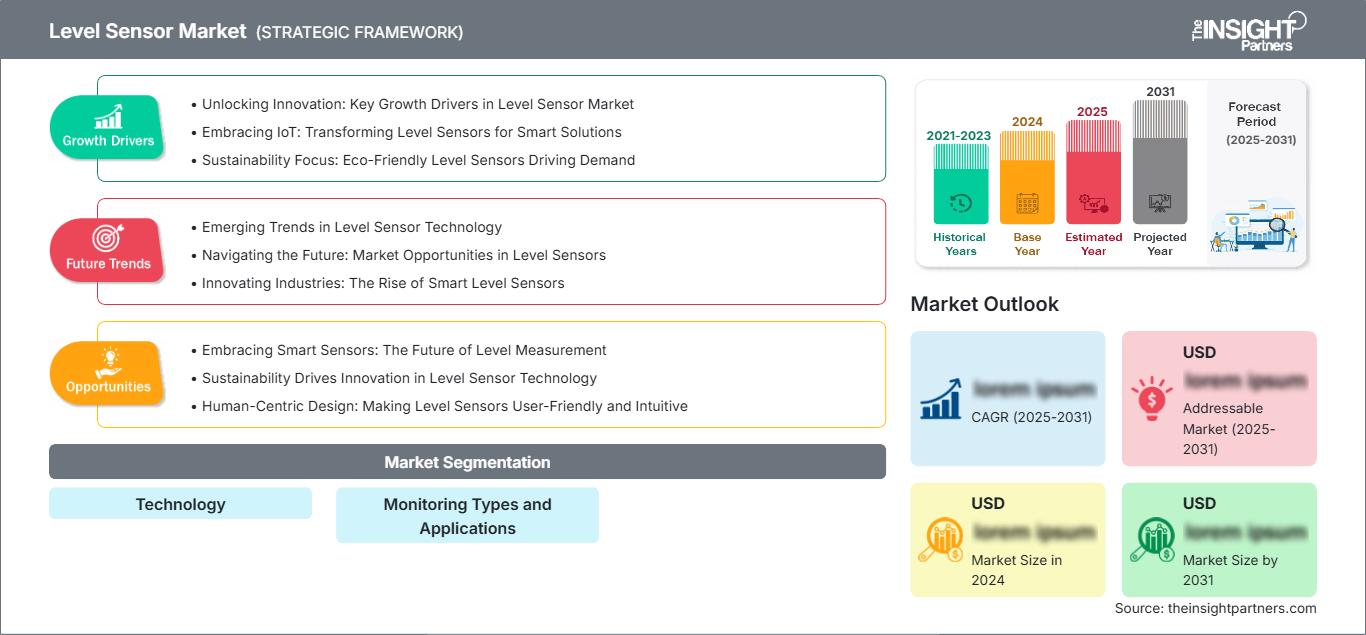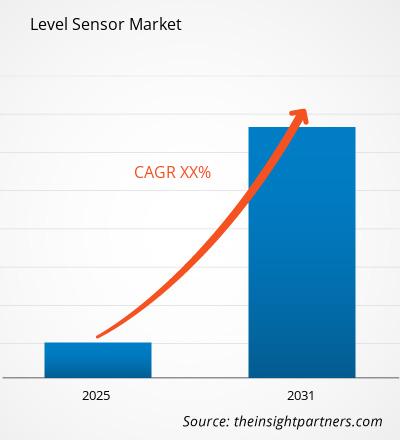I sensori di livello vengono utilizzati per rilevare il livello di liquidi, fluidi e solidi fluidizzati. I sensori di livello includono diverse tecnologie di rilevamento e tipologie di applicazioni. In generale, il mercato dei sensori di livello è suddiviso in due categorie: sensori di livello statico (materiali solidi fluidizzati) e sensori di livello di flusso (oggetti liquidi). Con il progresso dell'elettronica digitale, caratteristiche dei sensori di livello come facilità d'uso, affidabilità, facile accessibilità e riduzione dei costi sono state migliorate, il che è stato analizzato per guidare la crescita del mercato dei sensori di livello. Inoltre, si prevede che le normative governative nei settori industriale ed energetico stimoleranno ulteriormente il mercato globale dei sensori di livello. L'implementazione di sensori di livello multiuso per l'industria manifatturiera e la produzione di veicoli contribuisce ulteriormente alla crescita del mercato dei sensori di livello. Un altro fattore che porta a una crescita significativa del mercato dei sensori di livello è la miniaturizzazione dei sensori di livello. Con la rapida crescita e la presenza di numerose industrie manifatturiere nella regione Asia-Pacifico, si prevede che il mercato dei sensori di livello nella regione Asia-Pacifico si rafforzerà durante il periodo di previsione. Sebbene il mercato attuale sia dominato dai sensori di livello a contatto, si prevede una forte crescita del segmento dei sensori di livello senza contatto durante il periodo di previsione. Le aziende stanno sviluppando sensori di livello senza contatto più avanzati, come quelli a microonde, a celle di carico, a ultrasuoni, laser, ottici e nucleari, che offrono vantaggi rispetto ai sensori di livello a contatto. Con una maggiore attenzione alla ricerca e sviluppo (R&S) per le nanotecnologie e al miglioramento delle applicazioni e dei prodotti per il rilevamento del livello, in linea con l'evoluzione tecnologica, si prevede che il mercato globale dei sensori di livello crescerà in modo significativo. Aziende multinazionali come Siemens AG, ABB Ltd., Emerson Electric Co., Honeywell Sensing & Control, tra le altre, stanno investendo massicciamente in acquisizioni e attività di R&S per lo sviluppo innovativo delle tecnologie di rilevamento del livello senza contatto. Tuttavia, l'ampio utilizzo della tecnologia a film sottile per la produzione di prodotti di rilevamento ostacola il mercato dei sensori di livello. L'implementazione di tecnologie diverse per la produzione di prodotti di rilevamento del livello simili è un altro importante problema che i fornitori devono affrontare. Il mercato globale dei sensori di livello è stato suddiviso, in base alla tecnologia, in sensori di livello a contatto e sensori di livello senza contatto. Inoltre, il mercato è stato segmentato in base al tipo di monitoraggio: sensori di livello per il monitoraggio di solidi, sensori di livello per il monitoraggio di liquidi e sensori di livello per il monitoraggio di solidi e liquidi. Inoltre, il mercato globale dei sensori di livello è stato classificato in base alle applicazioni, ovvero: settore consumer, settore ICT e informatico, settore industriale, settore automobilistico e dei trasporti, settore energetico e dei servizi di pubblica utilità, settore sanitario, settore agricolo e settore militare e della difesa. Il mercato globale dei sensori di livello è stato suddiviso in cinque regioni geografiche: Nord America, Europa, Asia Pacifico (APAC), Medio Oriente e Africa (MEA) e Sud America (SAM). Con una serie di unità produttive avanzate, il Nord America è leader nel mercato globale dei sensori di livello. Si prevede che le iniziative governative progressiste nei paesi in via di sviluppo come Cina, India e Brasile per il trattamento delle acque reflue guideranno il mercato dei sensori di livello. Si ritiene che l'area Asia-Pacifico (APAC) sia la regione chiave per il mercato globale dei sensori di livello, grazie ai progressi tecnologici e alla crescente domanda di sensori ad alte prestazioni. Tra i principali attori che operano nel mercato globale dei sensori di livello figurano, tra gli altri, Pepperl+Fuchs AG, Vega GmbH, Gems Sensors & Control Co., Magnetrol International, Inc., Honeywell International, Inc., Endress+ Hauser AG, ABB Ltd. e Siemens AG.
Potrai personalizzare gratuitamente qualsiasi rapporto, comprese parti di questo rapporto, o analisi a livello di paese, pacchetto dati Excel, oltre a usufruire di grandi offerte e sconti per start-up e università
Mercato dei sensori di livello: Approfondimenti strategici

-
Ottieni le principali tendenze chiave del mercato di questo rapporto.Questo campione GRATUITO includerà l'analisi dei dati, che vanno dalle tendenze di mercato alle stime e alle previsioni.
Approfondimenti regionali sul mercato dei sensori di livello
Le tendenze regionali e i fattori che influenzano il mercato dei sensori di livello durante il periodo di previsione sono stati ampiamente spiegati dagli analisti di The Insight Partners. Questa sezione illustra anche i segmenti e la geografia del mercato dei sensori di livello in Nord America, Europa, Asia-Pacifico, Medio Oriente e Africa, America Meridionale e Centrale.
Ambito del rapporto di mercato sui sensori di livello
| Attributo del rapporto | Dettagli |
|---|---|
| Dimensioni del mercato in 2024 | US$ XX million |
| Dimensioni del mercato per 2031 | US$ XX Million |
| CAGR globale (2025 - 2031) | XX% |
| Dati storici | 2021-2023 |
| Periodo di previsione | 2025-2031 |
| Segmenti coperti | By TecnologiaBy Tipi e applicazioni di monitoraggio |
| Regioni e paesi coperti |
Nord America
|
| Leader di mercato e profili aziendali chiave |
|
Densità degli operatori del mercato dei sensori di livello: comprendere il suo impatto sulle dinamiche aziendali
Il mercato dei sensori di livello è in rapida crescita, trainato dalla crescente domanda degli utenti finali, dovuta a fattori quali l'evoluzione delle preferenze dei consumatori, i progressi tecnologici e una maggiore consapevolezza dei vantaggi del prodotto. Con l'aumento della domanda, le aziende stanno ampliando la propria offerta, innovando per soddisfare le esigenze dei consumatori e sfruttando le tendenze emergenti, alimentando ulteriormente la crescita del mercato.

- Ottieni il Mercato dei sensori di livello Panoramica dei principali attori chiave
- Analisi storica (2 anni), anno base, previsione (7 anni) con CAGR
- Analisi PEST e SWOT
- Valore/volume delle dimensioni del mercato - Globale, Regionale, Nazionale
- Industria e panorama competitivo
- Set di dati Excel
Report recenti
Rapporti correlati
Testimonianze
Motivo dell'acquisto
- Processo decisionale informato
- Comprensione delle dinamiche di mercato
- Analisi competitiva
- Analisi dei clienti
- Previsioni di mercato
- Mitigazione del rischio
- Pianificazione strategica
- Giustificazione degli investimenti
- Identificazione dei mercati emergenti
- Miglioramento delle strategie di marketing
- Aumento dell'efficienza operativa
- Allineamento alle tendenze normative






















 Ottieni un campione gratuito per - Mercato dei sensori di livello
Ottieni un campione gratuito per - Mercato dei sensori di livello